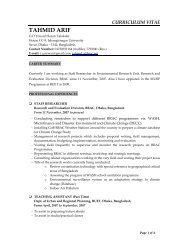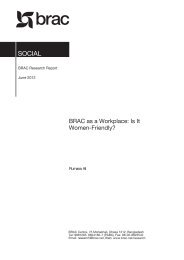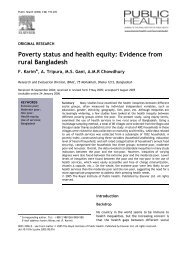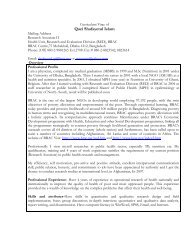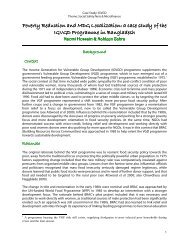Combining health and social protection measures to reach the ultra ...
Combining health and social protection measures to reach the ultra ...
Combining health and social protection measures to reach the ultra ...
You also want an ePaper? Increase the reach of your titles
YUMPU automatically turns print PDFs into web optimized ePapers that Google loves.
Decision-making<br />
Group I<br />
Group II<br />
Group III<br />
6%<br />
7%<br />
Group I<br />
Group II<br />
Group III<br />
36%<br />
54%<br />
87%<br />
10%<br />
Low- <strong>and</strong> middle-income countries<br />
High-income countries<br />
Figure 1: Deaths by broad cause group, 2001 Source: Ma<strong>the</strong>rs et al. 2006<br />
Europe <strong>and</strong> Central Asia, <strong>and</strong> Latin America <strong>and</strong> <strong>the</strong><br />
Caribbean, <strong>the</strong> proportion is well below 20%. The net effect<br />
of <strong>the</strong>se changes in age-specific mortality since 1990 has<br />
been <strong>to</strong> increase global life expectancy at birth by 0.7 years<br />
for females <strong>and</strong> by about twice this for males: a modest<br />
scorecard.<br />
Distribution of deaths by major cause group<br />
Worldwide, one death in every three is from a Group I cause.<br />
This proportion remains almost unchanged from 1990 with<br />
one big difference: whereas HIV/AIDS accounted for only 2%<br />
of Group I deaths in 1990, it accounted for 14% of Group I<br />
deaths in 2001. Excluding HIV/AIDS, Group I deaths fell from<br />
33% of <strong>to</strong>tal deaths in 1990 <strong>to</strong> less than 20% in 2001.<br />
Virtually all of <strong>the</strong> Group I deaths are in low- <strong>and</strong> middleincome<br />
countries. Just under 10% are from Group III causes<br />
(injuries) <strong>and</strong> almost 60% of deaths are from Group II causes<br />
(noncommunicable diseases). Figure 1 shows <strong>the</strong><br />
proportional distribution of <strong>the</strong>se major cause groups for low<strong>and</strong><br />
middle-income countries <strong>and</strong> high-income countries.<br />
Group I causes remain <strong>the</strong> leading cause of child deaths in<br />
all regions, although <strong>the</strong>y are now responsible for fewer child<br />
deaths than Group II <strong>and</strong> Group III combined in high-income<br />
countries (Figure 2). In contrast, Group II causes are now<br />
responsible for more than 50% of deaths in adults age 15 <strong>to</strong><br />
59 in all regions except South Asia <strong>and</strong> sub-Saharan Africa,<br />
where Group I causes, including HIV/AIDS, remain<br />
responsible for 33 <strong>and</strong> 67% of deaths, respectively. For<br />
adults age 15 <strong>to</strong> 59, death rates from Group II causes are<br />
higher for all low- <strong>and</strong> middle-income regions than for highincome<br />
countries, <strong>and</strong> in Europe <strong>and</strong> Central Asia are almost<br />
double <strong>the</strong> rate for <strong>the</strong> high-income countries. These results<br />
show that premature mortality from noncommunicable<br />
diseases is higher in populations with high mortality <strong>and</strong> low<br />
incomes than in <strong>the</strong> high-income countries.<br />
Leading causes of death<br />
Table 2 shows <strong>the</strong> <strong>to</strong>p 10 disease <strong>and</strong> injury causes of death<br />
in 2001 for low- <strong>and</strong> middle-income countries <strong>and</strong> for highincome<br />
countries. Ischaemic Heart Disease (IHD) <strong>and</strong><br />
cerebrovascular disease (stroke) were <strong>the</strong> leading causes of<br />
death in both groups of countries in 2001, responsible for 12<br />
million deaths globally, or almost one quarter of <strong>the</strong> global<br />
<strong>to</strong>tal. Only 1.4 million of <strong>the</strong> 7.1 million who died of IHD<br />
were in <strong>the</strong> high-income countries. Stroke killed 5.4 million,<br />
of whom less than 1.0 million were in high-income countries.<br />
Whereas lung cancer, predominantly due <strong>to</strong> <strong>to</strong>bacco<br />
smoking, remains <strong>the</strong> third leading cause of death in highincome<br />
countries reflecting high levels of smoking in previous<br />
years, <strong>the</strong> increasing prevalence of smoking in low- <strong>and</strong><br />
middle-income countries has not yet driven lung cancer in<strong>to</strong><br />
<strong>the</strong> <strong>to</strong>p 10 causes of death for <strong>the</strong>se countries. HIV/AIDS is<br />
<strong>the</strong> fourth leading cause of death in low- <strong>and</strong> middle-income<br />
countries, <strong>and</strong> HIV/AIDS death rates are projected <strong>to</strong> continue<br />
<strong>to</strong> rise, albeit at a slower pace, despite recent increased<br />
efforts <strong>to</strong> improve access <strong>to</strong> antiretroviral drugs.<br />
Lower respira<strong>to</strong>ry infections, conditions arising during <strong>the</strong><br />
perinatal period, <strong>and</strong> diarrhoeal diseases remain among <strong>the</strong><br />
<strong>to</strong>p 10 causes of death in low- <strong>and</strong> middle-income countries.<br />
In 2001, <strong>the</strong>se three causes of death <strong>to</strong>ge<strong>the</strong>r accounted for<br />
nearly 60% of child deaths globally.<br />
Table 3 shows <strong>the</strong> 10 leading causes of death in low- <strong>and</strong><br />
middle-income countries by sex in 2001. Leading causes of<br />
death are generally similar for males <strong>and</strong> females, although<br />
road traffic accidents appear in <strong>the</strong> <strong>to</strong>p 10 only for males <strong>and</strong><br />
diabetes appears only for females.<br />
Leading causes of death in children<br />
Infectious <strong>and</strong> parasitic diseases remain <strong>the</strong> major killers of<br />
children in <strong>the</strong> developing world. Although notable success<br />
has been achieved in certain areas, for example, polio,<br />
communicable diseases still account for 7 out of <strong>the</strong> <strong>to</strong>p 10<br />
causes <strong>and</strong> are responsible for about 60% of all child deaths.<br />
Overall, <strong>the</strong> 10 leading causes in low- <strong>and</strong> middle-income<br />
countries represent 80% of all child deaths in those<br />
countries, <strong>and</strong> also worldwide (Table 4).<br />
Many Latin American <strong>and</strong> some Asian <strong>and</strong> Middle Eastern<br />
countries have shifted somewhat <strong>to</strong>wards <strong>the</strong> cause of death<br />
pattern observed in developed countries. In <strong>the</strong>se countries,<br />
conditions arising during <strong>the</strong> perinatal period, including birth<br />
asphyxia, birth trauma, <strong>and</strong> low birth weight, have replaced<br />
infectious diseases as <strong>the</strong> leading cause of death <strong>and</strong> are now<br />
Global Forum Update on Research for Health Volume 4 ✜ 167




